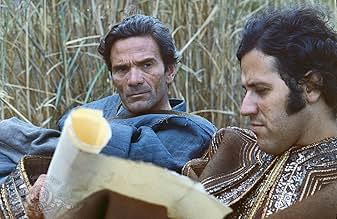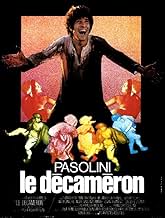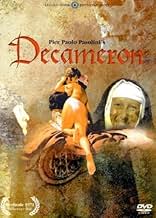AVALIAÇÃO DA IMDb
7,0/10
13 mil
SUA AVALIAÇÃO
Adaptação de nove contos do "Decamerão" de Boccaccio.Adaptação de nove contos do "Decamerão" de Boccaccio.Adaptação de nove contos do "Decamerão" de Boccaccio.
- Direção
- Roteiristas
- Artistas
- Prêmios
- 1 vitória e 3 indicações no total
Jovan Jovanovic
- Rustico
- (cenas deletadas)
Maria Gabriella Maione
- Una madonna
- (as Gabriella Frankel)
Pier Paolo Pasolini
- Allievo di Giotto
- (as P.P. Pasolini)
- Direção
- Roteiristas
- Elenco e equipe completos
- Produção, bilheteria e muito mais no IMDbPro
Avaliações em destaque
This film is a portmanteau film based on the famous 14th Century Italian story collection "The Decameron" by Giovanni Boccaccio. The book deals with ten people telling a story each every day for ten days, but Pier Paolo Pasolini (for obvious reasons) chooses merely nine stories for his film. Most of the stories deal with sex or deception (usually both).
Like all portmanteau films, some stories are better than others, but most of the stories in this film are so short that, if you don't enjoy one story, you don't have to wait long for the next one.
The film depicts a world filled with dirt and vulgarity but also full of life. Pasolini used a lot of ordinary people in his films and here we see many of the actors are not conventionally attractive (for example many have bad, or missing, teeth). Pasolini appears in the film as a pupil of the painter Giotto who is assigned to paint a mural on the wall of a church.
I found this film funny, charming and very entertaining. Definitely for adults though, there is quite a lot of sex and nudity on display here.
This was the first film in Pasolini's so-called "Trilogy of Life" and was followed by "The Canterbury Tales" and "The Arabian Nights".
Like all portmanteau films, some stories are better than others, but most of the stories in this film are so short that, if you don't enjoy one story, you don't have to wait long for the next one.
The film depicts a world filled with dirt and vulgarity but also full of life. Pasolini used a lot of ordinary people in his films and here we see many of the actors are not conventionally attractive (for example many have bad, or missing, teeth). Pasolini appears in the film as a pupil of the painter Giotto who is assigned to paint a mural on the wall of a church.
I found this film funny, charming and very entertaining. Definitely for adults though, there is quite a lot of sex and nudity on display here.
This was the first film in Pasolini's so-called "Trilogy of Life" and was followed by "The Canterbury Tales" and "The Arabian Nights".
Pasolini freely adapts ten or so episodes from Boccaccio's fourteenth century collection of hundred short stories. He interweaves the tales of happy or tragic lovers, naughty nuns and lusty priests, naive husbands and cheating but quick-witted wives, inept grave robbers, and a young gardener who got more than he had bargained for, with his own meditations on art, life, death and love. Pasolini himself plays a painter Giotto who observes the characters that inspire him to paint a fresco on the church's wall.
"Decameron" is the first part of Pasolini's "Trilogy Of Life", which continues with adaptations of two other celebrated works of world fiction; "The Canterbury Tales" (1972) and the "Arabian Nights" aka "A Thousand and One Nights" (1974). All these books have been known as distinguished and revered works of literature that belong to the immortal classics. There are probably so many big volumes have been written about them that it would take more than a thousand and one days and nights to read them. They talk about love, death, the meaning of life, and religion but first and most of all they entertain. At the time they were told and written down, no one would think of them as the future academic references. That's why they are so alive, earthy, coarse, and bold. I have not seen two other Pasolini's films but 'Decameron' captures the original spirit of Boccaccio's tales truthfully and with love, humanity, and perfect sense of the medieval Italy.
The film has a look of a renaissance painting not only Italian Renaissance (Giotto) but Netherlandish Northern Renaissance - Peter Bruegel and Hieronymus Bosch.
As he often did, Pasolin used in the film the non-professional actors to play the medieval peasants. They had none of the Hollywood glamor or classical features or perfect teeth and smiles but their faces are interesting, original, and real.
Full of rustic comedy and innocence, earthy humor and lust for life "Decameron" is one of the most optimistic, and celebrating life films ever made. Its sexuality is straightforward and honest, moving and not insulting. This film, my first Pasolini made me want to see the rest of the trilogy and the rest of his films.
"Decameron" is the first part of Pasolini's "Trilogy Of Life", which continues with adaptations of two other celebrated works of world fiction; "The Canterbury Tales" (1972) and the "Arabian Nights" aka "A Thousand and One Nights" (1974). All these books have been known as distinguished and revered works of literature that belong to the immortal classics. There are probably so many big volumes have been written about them that it would take more than a thousand and one days and nights to read them. They talk about love, death, the meaning of life, and religion but first and most of all they entertain. At the time they were told and written down, no one would think of them as the future academic references. That's why they are so alive, earthy, coarse, and bold. I have not seen two other Pasolini's films but 'Decameron' captures the original spirit of Boccaccio's tales truthfully and with love, humanity, and perfect sense of the medieval Italy.
The film has a look of a renaissance painting not only Italian Renaissance (Giotto) but Netherlandish Northern Renaissance - Peter Bruegel and Hieronymus Bosch.
As he often did, Pasolin used in the film the non-professional actors to play the medieval peasants. They had none of the Hollywood glamor or classical features or perfect teeth and smiles but their faces are interesting, original, and real.
Full of rustic comedy and innocence, earthy humor and lust for life "Decameron" is one of the most optimistic, and celebrating life films ever made. Its sexuality is straightforward and honest, moving and not insulting. This film, my first Pasolini made me want to see the rest of the trilogy and the rest of his films.
The erotic and more or less picaresque stories of which this movie is composed is based upon a collection of tales written in the 14th century by Bocaccio an Italian writer already called the Voltaire of 14th century. In the Middle Ages there was a tendency later abandoned, of considering erotic adventures under a humoristic point of view. The most common "hero" of those tales was the cuckold husband. I'm not a great fan of Pasolini. However this movie is more or less successful in depicting a series of funny situations related with erotic entanglements. Its merit is more due to the narrative form than to the stories itselves some them less funny than others. But the composition of the successive scenes develops in a series of pictures full of colour and movement portraying the people in the streets in a realistic way, showing popular types such as peasants, merchants, priests, nuns, etc. most of them with no make-up at all which contributes to create a vivid atmosphere that really puts us in the middle of a mediaeval scenery. Not a masterwork but something worth to be seen anyway.
The first of what became Pier Poalo Pasolini's Trilogy of Life, with each film adapting stories from archaic literature. In this case, Giovanni Boccaccio's book of the same name, written in 14th century Italy. The film takes nine of the 100 stories from the book and weaves them into vignettes of everyday Medieval life. We see nymphomaniac nuns, grave robbing, deceit, and cuckolding. In one segment, a boy is lured into the house of a pretty girl. She tells him that he is her brother. however, after taking his clothes and money, the boy is thrown out, where he is picked up by a couple of thieves who recruit him to climb inside of a tomb and steal the recently dead archbishop's ruby ring. The boy is left trapped in the grave.
This bawdy romp is a lot of fun. This was a surprise being Pasolini. The portmanteau style storytelling works well with this roaming tour through a debauched, ancient landscape. Many of the oddball characters were non- actors (something Pasolini had used throughout his career), and some have such incredibly rickety teeth, and are a strange and uncomfortable, yet thoroughly enjoyable watch.
The film ends with a statement by Pasolini himself (he played the painter, Giotto between, and within some of the stories), which is possibly a statement about the dream like quality the narrative has in its assemblage of the parts. He says: Why create a work of art, when you can just dream about it? Indeed, why create narrative cinema, when you can manoeuvre through scenes of life and create a patchwork of living, permeated with verisimilitude.
www.the-wrath-of-blog.blogspot.com
This bawdy romp is a lot of fun. This was a surprise being Pasolini. The portmanteau style storytelling works well with this roaming tour through a debauched, ancient landscape. Many of the oddball characters were non- actors (something Pasolini had used throughout his career), and some have such incredibly rickety teeth, and are a strange and uncomfortable, yet thoroughly enjoyable watch.
The film ends with a statement by Pasolini himself (he played the painter, Giotto between, and within some of the stories), which is possibly a statement about the dream like quality the narrative has in its assemblage of the parts. He says: Why create a work of art, when you can just dream about it? Indeed, why create narrative cinema, when you can manoeuvre through scenes of life and create a patchwork of living, permeated with verisimilitude.
www.the-wrath-of-blog.blogspot.com
After adapting "Gospel according to Saint-Matthews" as no one had done before (and after ) him ,in a drastically anti-Hollywood style ("greatest story ever told" and the Italian's opus are worlds apart),Pasolini brushed away the cobwebs from Greek myths such as "Oedipe" and "Medea".Then he began his trilogy of life which would also encompass "the Canterbury tales" and "fiore della mille e una notte".
"Il decameron" is the first and it created the surprise in 1971:no one had been as bawdy as Pasolini at the time (and I wonder if someone had since).This is a movie made up of little sketches ,all adapted from
Boccacio and they respect the original stories (notably the" nightingale" segment)Probably the funniest of the trilogy,and the happiest -both "Canterbury" and "mille e una" feature some dark scenes :a gay is burned alive in the former,an adolescent's murdered in the latter.
That said,"Il decameron" and the two other parts are not for all tastes:bawdiness,vulgarity and scatology may repel some.
"Il decameron" is the first and it created the surprise in 1971:no one had been as bawdy as Pasolini at the time (and I wonder if someone had since).This is a movie made up of little sketches ,all adapted from
Boccacio and they respect the original stories (notably the" nightingale" segment)Probably the funniest of the trilogy,and the happiest -both "Canterbury" and "mille e una" feature some dark scenes :a gay is burned alive in the former,an adolescent's murdered in the latter.
That said,"Il decameron" and the two other parts are not for all tastes:bawdiness,vulgarity and scatology may repel some.
Você sabia?
- CuriosidadesO Decameron (1971) is the first film in Pier Paolo Pasolini's "Trilogy of Life," continuing with Os Contos de Canterbury (1972) and concluding with As Mil e Uma Noites (1974). Each film was an adaptation of a different piece of classical literature focusing on ribald and often irreligious themes. The tales contain abundant nudity, sex, slapstick and scatological humor.
- Erros de gravaçãoWhen the Mother Superior seduces the deaf-mute boy, he's sleeping in a tomato garden. Tomatoes are a New World crop that wouldn't be brought to Italy for another two centuries. The same is true of the corn (maize) growing in the convent's little field.
- Citações
Allievo di Giotto: Why create a work of art when dreaming about it is so much sweeter?
- Versões alternativasAlthough the cinema version was intact the 1988 UK Warner video was cut by 22 secs by the BBFC to remove shots of naked genitals during the bedroom sex scene with the nun. The cuts were fully restored in the 2001 BFI DVD release.
- ConexõesEdited into Porno & libertà (2016)
- Trilhas sonorasFenesta Ca Lucive
Written by Guglielmo Cottrau, Vincenzo Bellini and Giulio Genoino in 1842
Performed by Franco Citti
Sung by Ser Ciappelletto and his Neapolitan hosts in Germany. Also sung by one of the Neapolitans to a monk.
Principais escolhas
Faça login para avaliar e ver a lista de recomendações personalizadas
- How long is The Decameron?Fornecido pela Alexa
Detalhes
- Data de lançamento
- Países de origem
- Idiomas
- Também conhecido como
- El decamerón
- Locações de filme
- Empresas de produção
- Consulte mais créditos da empresa na IMDbPro
Bilheteria
- Faturamento bruto mundial
- US$ 839
- Tempo de duração
- 1 h 51 min(111 min)
- Mixagem de som
- Proporção
- 1.85 : 1
Contribua para esta página
Sugerir uma alteração ou adicionar conteúdo ausente




























